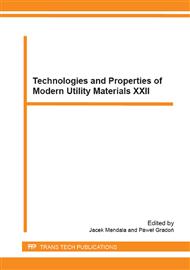p.173
p.177
p.185
p.189
p.193
p.199
p.205
p.209
p.215
Analysis of the Possibilities Using of the Post-Reaction Gases Enthalpy from the Ferrosilicon Smelting Process
Abstract:
The paper presents an analysis of the possibilities of using the enthalpy of post-reaction gases from the ferrosilicon smelting process to produce electricity. Ferrosilicon smelting in the submerged arc furnace is one of the most energy-consuming electro thermal processes. Post-reaction gases, generated during the silica reduction process with carbon, contain significant amounts of energy. In the past the issue of energy recovery from the ferrosilicon process has been repeatedly taken, but for the Polish ferroalloy industry it is still valid. In order to determine the amount of energy possible for recovery calculations based on mass and energy balances has been carried out and determined the stream enthalpy of post processing gas. For preparing the balance sheets has been used operational data from the 20 MVA furnace and the overall reaction of the silica reduction process. It was assumed that the reduction process occurs at a temperature of 1650°C, and the temperature of leaving post-reaction gas, whose main ingredients are oxides CO and SiO, is 750°C.
Info:
Periodical:
Pages:
215-218
Citation:
Online since:
January 2015
Authors:
Keywords:
Price:
Сopyright:
© 2015 Trans Tech Publications Ltd. All Rights Reserved
Share:
Citation:


